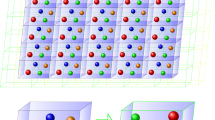Abstract
The energy of a shear dislocation ring is calculated in the framework of the Peierls model in which the displacement is represented by a density of infinitesimal dislocations in the glide plane. This avoids the introduction of an uncertain core cut-off radiusr 0 to prevent divergence in the usual treatment. The atomic misfit energy in the glide plane is accounted for explicitly and the influence of the interplanar potential on the ring energy and the core structure is studied. Whereas spontaneous formation of shear rings in a homogenous stress field can be ruled out, the emission of dislocation rings from crack tips in glide planes not containing the crack front is feasible.
Similar content being viewed by others
References
Orowan E.: Z. Phys.89 (1934) 634.
Cottrell A.H.:in Dislocations and Plastic Flow in Crystals, Oxford University Press, Fair Town (N.J.), 1953, p. 53.
Nabarro F.R.N.: Adv. in Phys.1 (1952) 269.
Kroupa F.: Czech. J. Phys. B10 (1960) 284.
Kroupa F.: Czech. J. Phys. B12 (1962) 191.
Kroupa F.: Philos. Mag.7 (1962) 783.
Franz H. and Kröner E.: Z. Metallkd.46 (1955) 539.
Eshelby J.D.: Proc. Roy Soc. A241 (1957) 376.
Nabarro F.R.N.: Philos. Mag.42 (1959) 912.
Kroupa F.: Phys. Status Solidi9 (1965) 27.
Schoeck G. and Püschl W.: Philos. Mag.64 (1991) 931.
Nabarro F.R.N.: Proc. Phys. Soc.59 (1947) 1197.
Chou Y.T. and Eshelby J.D.: J. Mech. Phys. Solids10 (1962) 27.
Kirchner H.O.K.: Philos. Mag. A43 (1981) 1193.
Schoeck G. and Kirchner H.O.K.: J. Phys. F., Met. Phys.8 (1977) 43.
Hirth J.P. and Lothe J.: Theory of Dislocations, John Wiley (1982).
Burns S.J. and Webb W.W.: Trans. Met. Soc. AIME236 (1966) 1165.
Argon A.S.: Acta Met.35 (1987) 185.
Scattergood R.O. and Bacon D.J.: Philos. Mag.31 (1975) 179.
Kröner E.:in Kontinuum Theorie der Versetzungen und Eigenspannungen, Springer, Berlin, 1958, p. 164.
Seeger A. and Schoeck G.: Acta Met.1 (1953) 519.
Lothe J.:in Elastic Strain Fields and Dislocation Mobility (Ed. V.L. Indenbom and J. Lothe), North Holland, Amsterdam, 1992, p. 186.
Schoeck G.: Acta Met. et Mat. (in print).
Hirsch P.B. and Roberts S.G.: Philos. Mag. A64 (1991) 55.
Rice J.R.: J. Mech. Phys. Solids40 (1992) 239.
Schoeck G.: J. Mech. Phys. Solids (accepted).
Schoeck G.: Philos. Mag. A69 1085 (1994).
Author information
Authors and Affiliations
Additional information
The paper is dedicated to Dr. František Kroupa in honour of his 70th birthday.
Stimulating discussions with miss Petra Fiala are gratefully acknowledged.
Rights and permissions
About this article
Cite this article
Schoeck, G. The Peierls model for dislocation rings. Czech J Phys 45, 991–1002 (1995). https://doi.org/10.1007/BF01692015
Received:
Issue Date:
DOI: https://doi.org/10.1007/BF01692015




